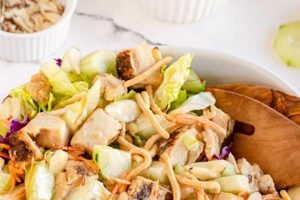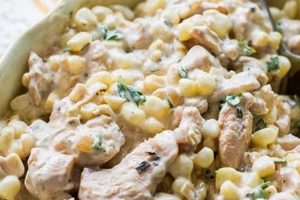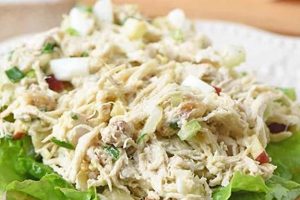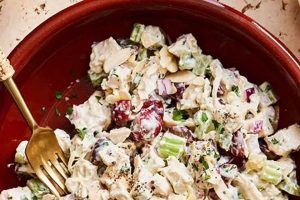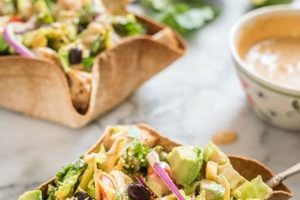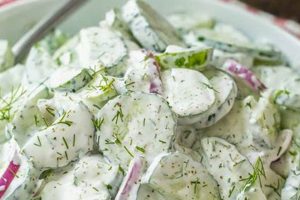This dish blends the vibrant flavors of traditional Lao larb with the familiar format of a chicken salad. Typically, it involves ground or minced chicken, seasoned with fish sauce, lime juice, toasted rice powder, and fresh herbs like mint, cilantro, and green onions. Variations may include shallots, chilies, and other vegetables, offering a complex and refreshing culinary experience.
The appeal lies in its balance of savory, sour, spicy, and herbaceous notes. It offers a lighter, healthier alternative to mayonnaise-based chicken salads, while providing a rich source of protein and fresh ingredients. Grounded in Lao cuisine, this preparation reflects a broader trend of incorporating global flavors into familiar dishes. This adaptation allows a wider audience to experience the unique taste profile of larb, contributing to culinary exploration and appreciation.
Further exploration will delve into specific ingredient choices, preparation methods, and serving suggestions, offering a practical guide to crafting and enjoying this unique dish. Nutritional information and variations will also be discussed, providing a comprehensive understanding of its versatility and health benefits.
Tips for Crafting the Perfect Larb Chicken Salad
Achieving optimal flavor and texture requires attention to detail throughout the preparation process. The following tips provide guidance for creating a truly exceptional dish.
Tip 1: Toast the Rice Powder: Toasting rice powder in a dry skillet until golden brown unlocks its nutty aroma and adds a crucial layer of complexity.
Tip 2: Freshly Squeeze Lime Juice: Bottled lime juice lacks the vibrant acidity of fresh limes. Freshly squeezed juice significantly elevates the overall flavor profile.
Tip 3: Balance Flavors: Taste and adjust the fish sauce, lime juice, and chili to achieve the desired balance of salty, sour, and spicy.
Tip 4: Use High-Quality Fish Sauce: The quality of the fish sauce impacts the final result. Opt for a reputable brand known for its clean, balanced flavor.
Tip 5: Properly Prepare the Chicken: Finely minced or ground chicken is preferred for optimal texture. Ensure the chicken is thoroughly cooked before combining it with other ingredients.
Tip 6: Don’t Overcrowd the Pan: When toasting the rice powder or cooking the chicken, avoid overcrowding the pan, which can lead to uneven cooking and steaming.
Tip 7: Incorporate Fresh Herbs Generously: Fresh mint, cilantro, and green onions are essential components. Use them liberally to maximize their refreshing and aromatic contribution.
By following these tips, one can create a larb chicken salad that exemplifies the dish’s characteristic vibrancy and balance. Attention to detail, from ingredient selection to preparation techniques, ensures a truly satisfying culinary experience.
The following section offers variations and serving suggestions to further enhance enjoyment and explore the adaptability of this remarkable dish.
1. Fresh, High-Quality Ingredients
The success of a larb chicken salad hinges on the quality of its ingredients. Freshness is paramount, as the dish relies on the vibrant flavors of herbs, citrus, and aromatics. Subpar ingredients will diminish the overall impact, resulting in a bland and uninspired final product.
- Fresh Herbs:
Herbs like mint, cilantro, and Thai basil are fundamental to larb’s flavor profile. Wilted or dried herbs lack the necessary vibrancy and aroma. Freshly picked herbs offer a bright, herbaceous counterpoint to the other ingredients, creating a balanced and refreshing taste. The quantity of herbs used significantly influences the final dish, with generous portions contributing to an authentic larb experience.
- Lime Juice:
Freshly squeezed lime juice provides essential acidity. Bottled lime juice often contains preservatives and lacks the bright, citrusy notes of fresh limes. The acidity balances the richness of the chicken and the saltiness of the fish sauce, creating a complex flavor profile. The correct balance of lime juice is crucial, as too much can overpower the dish, while too little leaves it lacking vibrancy.
- Chicken:
High-quality chicken, preferably free-range or organic, contributes to both flavor and texture. The chicken should be fresh, not frozen, and properly cooked to ensure food safety. The cooking method impacts the final result; grilling or pan-frying imparts a subtle char, while poaching or steaming results in a more delicate texture.
- Fish Sauce:
Fish sauce provides a savory, umami depth. The quality of the fish sauce significantly impacts the final flavor. A good fish sauce should have a balanced, savory flavor, not overly fishy or pungent. Using a premium fish sauce enhances the overall complexity of the larb, contributing to an authentic and satisfying taste experience.
The interplay of these high-quality, fresh ingredients creates the complex and balanced flavor profile characteristic of larb chicken salad. Compromising on ingredient quality diminishes the overall culinary experience. Sourcing the best ingredients ensures a vibrant, authentic, and thoroughly enjoyable dish.
2. Authentic Flavor Profile
An authentic flavor profile is crucial for any larb chicken salad recipe, distinguishing it from other chicken salads and aligning it with traditional Lao cuisine. Achieving authenticity requires understanding the key flavor components and their interplay, ensuring the final dish captures the essence of larb’s distinctive taste.
- Balance of Salty, Sour, Spicy, and Umami
The hallmark of larb’s flavor profile is the harmonious balance of salty, sour, spicy, and umami notes. Fish sauce provides saltiness and umami, lime juice delivers sourness, and chilies contribute spiciness. This balance is essential; an excess of any single element can disrupt the overall harmony. A well-executed larb exhibits a complex interplay of these flavors, creating a dynamic and satisfying taste experience.
- Fresh Herbs and Aromatics
Fresh herbs, such as mint, cilantro, and green onions, are integral to an authentic larb. These herbs provide a refreshing counterpoint to the richer flavors, adding a layer of complexity and aroma. Shallots, another key aromatic, contribute a subtle pungency that enhances the overall profile. The freshness of these ingredients is paramount; wilted or dried herbs significantly detract from the authenticity of the dish.
- Toasted Rice Powder
Toasted rice powder (khao khua) adds a unique nutty flavor and textural dimension often absent in other chicken salads. The toasting process is crucial, as it unlocks the rice’s inherent nuttiness. This ingredient contributes a subtle roasted flavor and a pleasing granular texture, further distinguishing larb from other similar preparations.
- Absence of Creamy Dressings
Traditional larb typically avoids creamy dressings like mayonnaise, which are common in Western-style chicken salads. The absence of these dressings allows the other flavors to shine, emphasizing the fresh, vibrant character of the dish. This distinction underscores the importance of understanding traditional preparations when aiming for an authentic flavor profile.
Recreating an authentic larb chicken salad flavor profile requires careful attention to these key elements. Faithfully incorporating these components ensures the final dish remains true to its Lao origins, offering a genuine and satisfying culinary experience that transcends mere adaptation.
3. Proper Cooking Techniques
Proper cooking techniques are essential for a successful larb chicken salad recipe. These techniques ensure both food safety and optimal flavor development, contributing significantly to the overall quality and enjoyment of the dish. Understanding and implementing these techniques elevates the final product from merely acceptable to truly exceptional.
- Chicken Preparation
Chicken, the central protein component, requires careful handling and cooking. Thorough cooking eliminates potential health risks associated with consuming raw or undercooked poultry. Methods such as poaching, grilling, or pan-frying can be employed, each imparting subtle nuances to the final flavor and texture. Poaching results in a more tender, delicate texture, while grilling or pan-frying adds a char and smoky depth. The chosen cooking method should complement the desired final flavor profile.
- Toasting Rice Powder
Toasting rice powder is essential for unlocking its nutty aroma and flavor. Dry-roasting in a pan over medium heat until golden brown enhances its inherent nuttiness, adding depth to the overall flavor profile. Uneven toasting can lead to a bitter taste, so consistent heat and careful attention are crucial. The toasted rice powder contributes not only flavor but also a pleasant textural element to the salad.
- Balancing Flavors
Proper cooking also involves balancing the key flavors. The interplay of salty (fish sauce), sour (lime juice), spicy (chili), and umami requires careful adjustment throughout the process. Tasting and adjusting these elements ensures a harmonious blend where no single flavor dominates. This balance is crucial for achieving the complex flavor profile characteristic of authentic larb.
- Incorporating Fresh Herbs
While not strictly a cooking technique, the proper incorporation of fresh herbs is essential. Adding delicate herbs like mint and cilantro at the end of the process, rather than during cooking, preserves their vibrant flavors and aromas. Overexposure to heat can wilt the herbs and diminish their delicate flavors, negatively impacting the overall freshness of the salad.
Mastery of these cooking techniques contributes significantly to the overall success of a larb chicken salad recipe. Properly cooked chicken, toasted rice powder, and balanced flavors are essential elements that elevate the dish from a simple salad to a culinary experience reflecting the vibrant and nuanced flavors of Lao cuisine.
4. Textural Balance
Textural balance is a crucial aspect of a successful larb chicken salad recipe. It elevates the dish beyond simply a combination of flavors, engaging the sense of touch and creating a more dynamic eating experience. This balance arises from the interplay of various textural elements, each contributing to the overall complexity and enjoyment of the salad.
The primary textural components include the ground chicken, toasted rice powder, fresh herbs, and optional additions like chopped nuts or shredded vegetables. Ground chicken provides a foundational protein base, offering a slightly chewy texture. Toasted rice powder introduces a delicate crunch and subtle grittiness, contrasting with the softer chicken. Fresh herbs contribute a refreshing lightness and a slightly leafy texture, further enhancing the complexity. Incorporating chopped peanuts or cashews introduces a satisfying nuttiness and additional crunch, while shredded carrots or cucumbers offer a contrasting crispness.
The interplay of these textures is essential. A larb chicken salad lacking textural diversity can feel monotonous and one-dimensional. Consider the difference between a salad with uniformly soft ingredients and one that incorporates crunchy, crispy, and chewy elements. The latter offers a more engaging and satisfying sensory experience. Achieving this balance involves considering the texture of each ingredient and ensuring a variety of textures are present in the final dish. Practical application involves mindful ingredient selection and preparation, such as properly toasting the rice powder to achieve optimal crispness and chopping vegetables to a size that complements the other textures.
In summary, textural balance is a defining characteristic of a well-executed larb chicken salad. It elevates the dish by engaging multiple senses, creating a more dynamic and satisfying culinary experience. Understanding the role of each ingredient’s texture and thoughtfully combining them ensures a harmonious blend that exemplifies the complexity and balance inherent in this traditional Lao dish.
5. Presentation and Serving
Presentation and serving are integral components of the overall larb chicken salad experience. While flavor and texture are paramount, the visual appeal and manner of serving contribute significantly to enjoyment and appreciation. Thoughtful presentation enhances the perceived value of the dish, transforming it from a simple meal to a more engaging culinary experience.
- Traditional Serving Vessels
Traditionally, larb is served on a platter or in a shallow bowl, often accompanied by lettuce cups, sticky rice, and fresh vegetables. These elements are not mere accompaniments but integral parts of the presentation and consumption process. Lettuce cups provide a fresh, crisp vessel for the flavorful salad, while sticky rice offers a neutral base to balance the complex flavors. The use of traditional serving vessels enhances authenticity and provides a culturally relevant context.
- Garnishing and Visual Appeal
Garnishing plays a crucial role in enhancing visual appeal. Fresh herbs, such as sprigs of mint or cilantro, not only add a pop of color but also reinforce the fresh, herbaceous nature of the dish. A sprinkle of toasted rice powder or chopped nuts adds textural contrast and visual interest. Thoughtful garnishing elevates the presentation, making the dish more enticing and appetizing.
- Portioning and Accompaniments
Proper portioning and the choice of accompaniments further enhance the dining experience. Serving larb in appropriate portions ensures guests can fully appreciate the flavors without feeling overwhelmed. Accompaniments, such as fresh vegetables like cucumber and carrots, provide refreshing contrasts in texture and flavor, complementing the richness of the larb. Consideration of these elements demonstrates attention to detail and enhances overall enjoyment.
- Adaptation for Different Contexts
While traditional presentation is valued, adapting the serving style to different contexts demonstrates versatility. Larb chicken salad can be served as an appetizer in smaller portions, presented on individual spoons or small lettuce cups. It can also be a main course, served with a larger portion of sticky rice and a variety of accompanying vegetables. Adaptability allows the dish to be enjoyed in various settings, from casual gatherings to more formal occasions.
Presentation and serving, therefore, are not merely afterthoughts but essential considerations in preparing and enjoying larb chicken salad. Thoughtful presentation enhances the dining experience, showcasing the dish’s vibrant flavors and textures while reflecting an appreciation for culinary artistry and cultural context.
6. Dietary Adaptations
Dietary adaptations are crucial for expanding the accessibility of larb chicken salad recipes. Food sensitivities, intolerances, and ethical dietary choices necessitate modifications without compromising the fundamental flavor profile. Adapting recipes broadens the audience, allowing individuals with dietary restrictions to enjoy this flavorful dish. Understanding these adaptations is vital for recipe developers and individuals seeking to cater to diverse dietary needs. Several key areas allow for adaptation within a traditional larb chicken salad framework.
Fish Sauce Alternatives: Fish sauce is a core component of traditional larb, providing a savory, umami depth. However, individuals with fish allergies or vegan/vegetarian dietary preferences require alternatives. Soy sauce, tamari, or coconut aminos can provide a similar salty, umami flavor. Mushroom-based sauces or seaweed flakes can also contribute umami notes. Careful selection of these alternatives ensures the adapted recipe retains the characteristic larb flavor profile. For example, using coconut aminos offers a slightly sweeter, less pungent alternative to fish sauce, suitable for those sensitive to strong flavors.
Gluten-Free Considerations: While traditional larb is typically gluten-free, ensuring all ingredients, especially sauces, are certified gluten-free is essential when catering to individuals with celiac disease or gluten sensitivity. Using tamari instead of traditional soy sauce is a common adaptation. Cross-contamination during preparation should also be avoided. For example, using dedicated cutting boards and utensils prevents accidental gluten exposure. This diligence is vital for maintaining the integrity of gluten-free diets.
Vegetarian/Vegan Adaptations: Adapting larb for vegetarian or vegan diets involves substituting the chicken with plant-based protein sources. Tofu, tempeh, or mushrooms can provide a satisfying textural and flavor base. These substitutions require adjustments to cooking methods and seasoning to ensure the final dish retains the characteristic larb flavor profile. For instance, marinated and pan-fried tofu can mimic the texture and absorb the flavors of the larb seasoning effectively. The choice of protein substitute impacts the overall nutritional profile, offering opportunities to cater to specific dietary needs.
Dietary adaptations demonstrate the versatility of larb chicken salad, enabling its enjoyment by a broader audience. Careful consideration of ingredient substitutions and preparation methods ensures these adaptations maintain the dish’s authentic flavor profile while accommodating diverse dietary requirements. This inclusivity expands culinary horizons and fosters a more inclusive and enjoyable dining experience for all.
Frequently Asked Questions
This section addresses common inquiries regarding larb chicken salad preparation and variations, providing concise and informative responses.
Question 1: What is the origin of larb chicken salad?
While traditional larb originates from Laos and Northeastern Thailand, featuring minced meat (typically pork or beef), the chicken salad adaptation reflects a fusion of culinary influences, making it accessible to a broader audience while retaining core flavor principles.
Question 2: Can larb chicken salad be prepared in advance?
While the flavors meld and intensify over time, the fresh herbs are best incorporated just before serving to maintain their vibrancy. The chicken and dressing components can be prepared a day ahead and stored separately, then combined with the herbs shortly before serving.
Question 3: What are suitable substitutes for fish sauce?
Soy sauce, tamari, or coconut aminos can offer similar salty and umami notes for individuals avoiding fish sauce. Mushroom-based sauces or seaweed flakes can also provide umami depth, though they may subtly alter the final flavor profile.
Question 4: How can spiciness be adjusted?
The amount of chili incorporated directly correlates with the level of spiciness. Start with a small amount and gradually increase to taste. Removing seeds and membranes from chilies before use also reduces heat. Serving with a side of plain yogurt or rice can help mitigate spiciness for those sensitive to heat.
Question 5: What are some suitable serving suggestions beyond lettuce cups?
Larb chicken salad can be served over rice, quinoa, or mixed greens. It can also be used as a filling for wraps, sandwiches, or spring rolls, offering versatility for various meal occasions.
Question 6: How can the nutritional content be maximized?
Incorporating a variety of fresh vegetables, such as shredded carrots, cucumber, or bell peppers, enhances both nutritional value and textural complexity. Choosing lean chicken breast and minimizing added oils further contributes to a healthier profile.
Understanding these common points of inquiry facilitates successful larb chicken salad preparation and adaptation to individual preferences. Experimentation with variations and mindful ingredient selection allows exploration of the dishs versatility while maintaining its essential characteristics.
This concludes the frequently asked questions section. The following section will offer a complete recipe for preparing larb chicken salad.
Larb Chicken Salad Recipe
Exploration of larb chicken salad recipes reveals a dish rooted in Lao tradition yet adaptable to modern culinary preferences. Emphasis on fresh, high-quality ingredients, authentic flavor profiles, proper cooking techniques, textural balance, and thoughtful presentation ensures a satisfying culinary experience. Dietary adaptations further broaden accessibility, accommodating various dietary needs and preferences without compromising the core essence of larb’s distinctive character.
Culinary exploration benefits from an understanding of both traditional foundations and innovative adaptations. Larb chicken salad exemplifies this principle, offering a pathway to experiencing authentic Southeast Asian flavors while encouraging culinary creativity and personalized interpretations. Continued exploration of global culinary traditions enriches gastronomic experiences and fosters cross-cultural appreciation.

